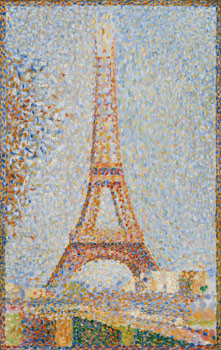Georges Seurat.
Figure in Space
4 February – 9 May, 2010
Römerberg
60311 Frankfurt, Germany
phone: (+49) 69-29 98 82-0
fax: (+49) 69-29 98 82-240
welcome [at] schirn.de
The French Neo-Impressionist Georges Seurat (1859–1891) is now revered as one of the icons of nineteenth-century art. Before his premature death at the age of thirty-one he created an outstanding oeuvre. Exploring the visual concepts of the Impressionists and contemporary scientific discoveries of color theory, Seurat developed a painting technique that became famous as Pointillism, an important source of inspiration for later artists. Seurat’s works are meticulously composed from countless juxtaposed small dots of paint, which are blended by the viewer’s retina into stunning worlds of color. With around 60 paintings, oil studies, and drawings from public and private collections in London, Paris, Zurich, New York, and San Francisco, this exhibition will provide a representative overview while focusing on one significant aspect of Seurat’s oeuvre: the figure in space. Both the paintings and the drawings are witness to the artist’s enduring devotion to this subject throughout his creative life.
After taking drawing lessons for two years, Seurat entered the École des Beaux Arts in 1878 and began to study with Henri Lehmann, a pupil of Jean-Auguste-Dominique Ingres. After only one year – probably not least under the impression of the fourth Impressionist exhibition – Seurat left the Paris Academy and increasingly abandoned its traditions.
In the following years, Seurat extended his knowledge in the theory of colors and the effects of colors on the human eye beyond any academic constraints. He studied the works of the art theorist Charles Blanc, the writer and color theorist Charles Henry, and the American physicist Ogden N. Rood. He was also decisively influenced by the French chemist Michel-Eugène Chevreul’s theory of pigments regarding the perception of colors and additive color combination. Chevreul primarily explored the laws of simultaneous contrast and how colors change with increasing distance. Around 1883, Seurat, inspired by these scientific findings, developed his method of painting based on the simultaneous contrast of adjacent colors, which was to become famous under the name of Pointillism. Paints were dabbed onto the canvas with a brush in meticulously applied and densely packed dots. The overall impression of a surface’s or painting’s coloring only comes about in the eye of the beholder as an optical mixture when perceived from a certain distance.
“Un Dimanche à la Grande Jatte” (1884–1886), a key work of Neo-Impressionism and Seurat’s most remarkable composition, in which he uncompromisingly relied on the Pointillist technique for the first time, is presented in the Schirn in the form of several small-size preliminary studies. Widely discussed in the context of the eighth and last Impressionist exhibition in 1886, this work made Seurat the leader of the new avant-garde around Paul Signac, Camille Pissarro, and Maximilian Luce.
The treatment of the figure in space, which is also the central subject of the exhibition in the Schirn, is an issue running all the way through Seurat’s oeuvre. In numerous studies for his paintings, Seurat explored his figures from different perspectives, varied them, and captured them in different close-ups. Thus, he gradually arrived at the final composition of his paintings, in which he brought together the figures of his preliminary studies. Yet even when depicted together with others in groups, Seurat’s figures strike us as isolated, still, and withdrawn. Their linearity and geometrization endows them with an almost abstract character. In the case of Seurat, this immobilization or frozen representation, i.e., the decision to render states instead of goings-on, evinces archaic traits and documents his study of the masters relying on linearly closed forms like Raphael, Poussin, or Ingres, to whom he had dedicated himself in his youth.
Seurat’s oeuvre of drawings is of equal importance as his achievements as a painter. For almost all his drawings, the artist used a soft Conté crayon, a deep-black charcoal stick. The strokes cover the quite grainy paper as a dense web of rhythmic hatching and crosshatching, making the motif emerge or disappear as something floating and indefinite. Pronounced contrasts between light and dark shroud and accentuate the figures and lend them an unreal presence. Especially his later sheets – as well as his numerous oil sketches, which, contrary to the final paintings, are often characterized by quick Impressionist strokes – helped the artist find and perfect his compositions.
Seurat’s Pointillism proved to have a far-reaching impact on the development of Modernism. Artists like the Italian Futurists enthusiastically picked up Seurat’s thread and transferred his scientifically driven dynamics into the twentieth century. Bauhaus representatives raved about his unusual compositions and the geometrization of both his figures and his landscapes. Artists such as Agnes Martin found a basis for their drawing in Seurat’s graphic work.
The exhibition was prepared by the Kunsthaus Zürich in cooperation with the Schirn Kunsthalle Frankfurt.
CATALOG: Georges Seurat. Figure in Space. Edited by Zürcher Kunstgesellschaft/Kunsthaus Zürich. With a foreword by Max Hollein and texts by Christoph Becker, Gottfried Boehm, Julia Burckhardt Bild, Michelle Foa, and Wilhelm Genazino. English and German editions, 152 pages with 113 illustrations each, Hatje Cantz Verlag, Ostfildern 2009, ISBN 978-3-7757-2439-5 (English), ISBN 978-3-7757-2438-8 (German).
DIRECTOR: Max Hollein
CURATOR: Christoph Becker, Kunsthaus Zürich, with Julia Burckhardt Bild, co-curator of the exhibition at the Kunsthaus Zürich, and Katharina Dohm, curator Schirn Kunsthalle Frankfurt
OPENING HOURS: Tue, Fri–Sun, 10 am–7 pm; Wed and Thu, 10 am–10 pm
INFORMATION: www.schirn.de
PRESS CONTACT: Dorothea Apovnik, phone: (+49-69) 29 98 82-118, fax: (+49-69) 29 98 82-240, e-mail: dorothea.apovnik@schirn.de, www.schirn.de (texts, images and films for download under PRESS)
Follow us on twitter
Watch our videos on YouTube
Become our fan on facebook
Subscribe to our newsletter


